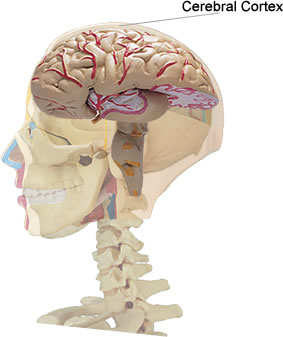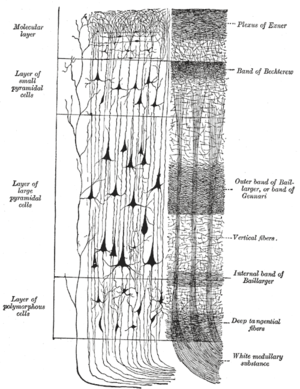Cerebral Cortex
Original Editor - Lucinda hampton
Top Contributors - Lucinda hampton, Rucha Gadgil and Joao Costa
Introduction[edit | edit source]
The cerebral cortex is a sheet of neural tissue that is outermost to the cerebrum of the mammalian brain. It has up to six layers of nerve cells. It is covered by the meninges and often referred to as gray matter[1]. The cortex is gray because nerves in this area lack the insulation (myelin) that makes most other parts of the brain appear to be white[2].
The cerebral cortex
- Represents in humans a highly developed structure concerned with the most familiar functions we associate with the human brain.
- Highly convoluted external surface of the brain. Its distinctive shape arose during evolution as the volume of the cortex increased more rapidly than the cranial volume resulting in the convolution of the surface and the folding of the total structure of the cortex.
- The convolutions consist of grooves known as sulci that separate the more elevated regions called gyri.
- The cortex has been divided into four lobes using certain consistently present sulci as landmarks. These lobes are named after the overlying cranial bones: frontal, parietal, temporal and occipital[3].
Neocortex[edit | edit source]
The phylogenetically most recent part of the cerebral cortex, the neocortex, has six horizontal layers (the more ancient part of the cerebral cortex, the hippocampus, has at most three cellular layers). Neurons in various layers connect vertically to form small microcircuits, called 'columns'.
Image:Cerebral cortex. To the left, the groups of cells; to the right, the systems of fibers. Quite to the left of the figure a sensory nerve fiber is shown. Cell body layers are labeled on the left, and fiber layers are labeled on the right.
- The neocortex is the newest part of the cerebral cortex to evolve. The six-layer neocortex is a distinguishing feature of mammals; it has been found in the brains of all mammals, but not in any other animals. In humans, 90% of the cerebral cortex is neocortex.
- In humans, 90% of the cerebral cortex and 76% of the entire brain is neocortex[4][1]
Allocortex[edit | edit source]
The allocortex (also known as heterogenetic cortex) is a part of the cerebral cortex characterized by fewer cell layers than the neocortex (i.e. fewer than six). More ancient phylogenetically than the mammals, evolved to handle olfaction and the memory of smells.
The specific regions of the brain normally described as part of the allocortex are:
Allocortex: fewer than six layers, more ancient phylogenetically than the mammals, evolved to handle olfaction and the memory of smells.
- Archicortex
- Olfactory cortex
- Hippocampus
2. Paleocortex (3 three to five layers)
The cellular organization of the old cortex is different from the six-layer structure mentioned above. Unable to form so many complex micro circuits.
Sub Heading 3[edit | edit source]
Resources[edit | edit source]
- bulleted list
- x
or
- numbered list
- x
References[edit | edit source]
- ↑ 1.0 1.1 Kidzsearch Cerebral Cortex Available from:https://wiki.kidzsearch.com/wiki/Cerebral_cortex (accessed 25.12.2020)
- ↑ Thought Co. What Does the Brain's Cerebral Cortex Do? Available from:https://www.thoughtco.com/anatomy-of-the-brain-cerebral-cortex-373217 (accessed 25.12.2020)
- ↑ Nervous system Available from:http://www.ifc.unam.mx/Brain/cercox.htm (accessed 25.12.2020)
- ↑ Science Daily Neocortex Available from:https://www.sciencedaily.com/terms/neocortex.htm (accessed 26.12.2020)








